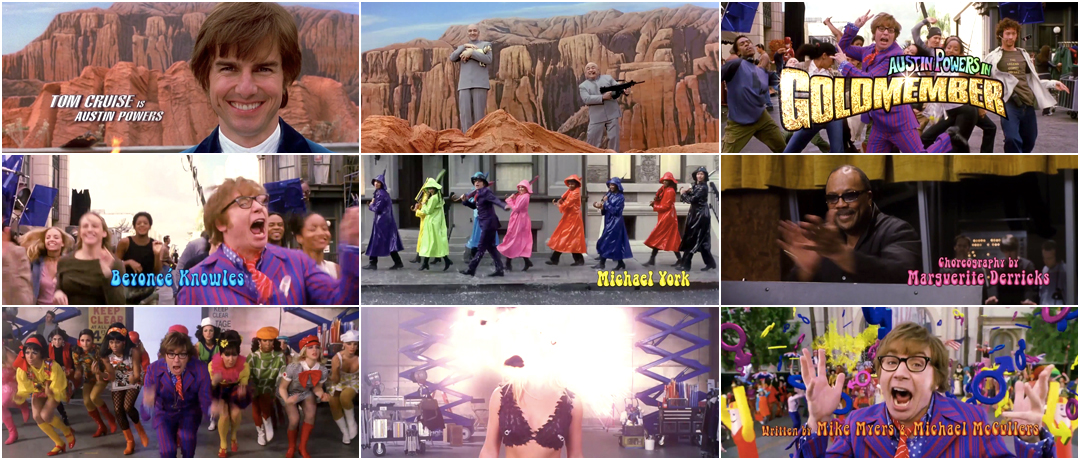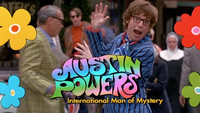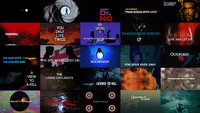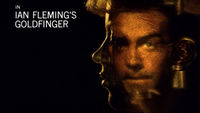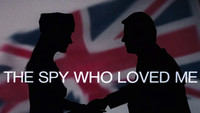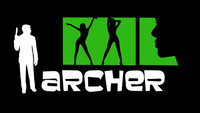The opening title sequence for the third Austin Powers film is an action-packed explosion of choreography, comedy, and celebrity.
For the third and last installment of the franchise, director Jay Roach and Austin Powers writing pair Mike Myers and Michael McCullers knew they had to go bigger. They had to bring the series into the new millennium while building on the legacy of the first two films and trying to avoid the dreaded sequelitis. So they created an action-packed, over-the-top smorgasbord of characters, sight gags, costumes and sets, as well as three separate dance numbers. The resulting sequence is a whirlwind medley of John Woo-style action, celebrity cameos, nods to classic Hollywood musicals and comedies, contemporary video vixens, and of course, a grand finale like no other.
By this point in the Austin Powers universe, Austin is a worldwide sensation and Hollywood has come knocking, optioning his story for a star-studded, big-budget blockbuster called – what else? – Austinpussy. Thus, the opening to Austin Powers in Goldmember is a two-for-one experience – a title sequence within a title sequence – introducing both Tom Cruise as Austin Powers and Mike Myers as Austin Powers. The sequence begins with skydiving and stunts in the desert (a nod to Mission: Impossible II), shifts to a studio backlot featuring Cruise as Powers and A-listers Gwyneth Paltrow as Dixie Normous, Kevin Spacey as Dr. Evil, and Danny DeVito as Mini-Me, all hamming it up in pitch perfect harmony. The sequence then moves into the first of its three separate dance sequences, all choreographed by Marguerite Pomerhn Derricks. As with the second Austin Powers film, The Spy Who Shagged Me, the titles typography was designed by Robert Dawson. This time, thanks to the increased budget and visual effects, he is joined by title designer Simon Cassels, and together they give the credits a heavy helping of depth, sheen, and glitter.
The sequence ends, as the Austin Powers title sequences always do, with a big finish – a “kitchen sink” finale, as director Jay Roach calls it – featuring a smorgasbord of various dancers, characters, stuntpeople and, to reflect the film’s more contemporary approach, a slew of visual effects. Look closely and read on to learn about the process behind the sequence and the sly easter egg-type treats you may have missed.
A discussion with Austin Powers Director JAY ROACH and Choreographer MARGUERITE POMERHN DERRICKS.
We’ve talked about the first two Austin Powers title sequences, but I’m especially excited to talk about Goldmember. What was the reaction like to this one? How did you start out planning this?
Jay: On the third one the title sequence got such a huge response it was actually difficult to sort of keep everybody as riveted to the film as they were to the title sequence! [laughs]
For us, it was risky because people might just be sick of us, you know? The studio was always behind it, because for them it’s a branded thing. But you never want to come back on stage for an encore unless you’re sure the audience is still on their feet clapping. The only way to do it was to make fun of having to live up to some sequel thing, being aware of sequelitis. But once Mike had this idea of calling it “Goldmember”, and having a new character, it pretty much accelerated off of that. Once we had the title idea, we thought, we can run with this. We can say to the audience, “Look, we know we’re lucky to be back, and to have this huge budget and we’re not going to squander our good will with you. We’re going to make fun of ourselves to your delight.” [laughs]
Deleted scene from the Austin Powers in Goldmember (2002) main title sequence featuring Austin Powers in a dressing room
The opening sequence, as you say, is a huge production. The locations, the effects, the dance routines were all bigger. Marguerite, how did you work with that?
Marguerite: Goldmember was just dance sequence, dance sequence, dance sequence. That was the biggest of the three for me. I remember John Lyons, one of the producers, called the opening sequence “Marguerite’s Masterpiece.” That was the first one that I got a full title credit at the beginning of the movie. And my name was on all the posters and the paid advertisements. As the films grew, Mike always made sure that he acknowledged my importance. He was so wonderful about that.
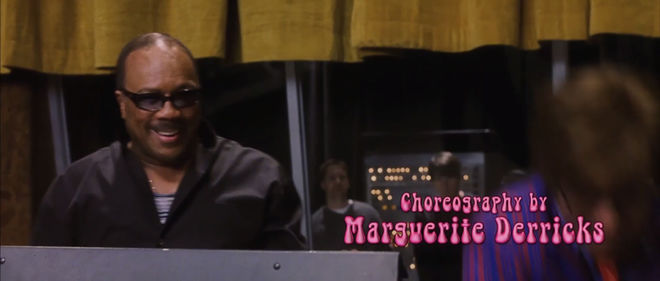
Still from the Austin Powers in Goldmember title sequence featuring "Soul Bossa Nova" writer Quincy Jones and the credit for Marguerite Derricks
One of the things that’s great about it is that it has this movie-in-a-movie thing happening, so the opening of Goldmember is really the opening of Austinpussy. And then likewise with the end credits. How did you work out those bookends for the movie?
Jay: I actually forgot there was a bookend! [laughs] We knew we had to deliver a kind of “awareness of the sequel” thing. We liked the idea that Austin admired himself so much that he could entertain the idea of Hollywood making a movie based on him but only if Tom Cruise could play him! [laughs] And only if Steven Spielberg could direct him. And only if his lead could be Gwyneth Paltrow! And then once we got John Travolta to come back at the end – turning himself into Goldmember – then it made even more sense. You could see it as poetic justice that the movie in the movie was a huge blockbuster.
Austinpussy movie-within-a-movie end credits scene featuring John Travolta as Goldmember
Jay: That gave us so much permission… I had been such a purist in the first movie towards a ’60s vibe that I never used digital opticals or steadicams or anything technological from contemporary times, in the late ’90s. I stuck with film techniques from the ’60s. So by the second one we were starting to be fancier, we had bigger villains, bigger Dr. Evil lairs on the moon, and it was starting to look pretty contemporary. By the third one, the idea was, let’s go even further towards contemporary to the point that it makes you nostalgic for the old ‘60s vibe. So the whole idea was to flip back after that Spielberg-directed sequence – quote-unquote – I mean, I directed that too but we wanted to make it look like Spielberg did. Then we flip back to the original eccentric dancing and Marguerite Derricks-style choreography and take him through this tribute to movies. Austin, because he was a recombinant DNA character, was always connected to movie history, so it gave us permission to go through all those different sets in the backlot. It was a pretty tight design – I was really happy with how that came out.
Marguerite: We had a lot more time to shoot this one. It wasn’t done in a day like the other two! Now we had at least a week to shoot this, ‘cause we were shooting on different locations on the Paramount set. It took a lot more planning, a lot more rehearsal, a lot more shoot time. But it was just fun!
Austin Powers in Goldmember (2002) main title sequence commentary featuring Director Jay Roach and Writer/Producer/Actor Mike Myers
Let’s go through the sequence a little, step-by-step. It has four or five different segments. First there’s the desert sequence with the Shaguar...
Jay: The desert sequence was a second unit shoot with two different directors, my old assistant who had started directing second unit on the first Austin Powers, Marco Schnabel, and another guy who had come out of the stunt world, Jack Gill, combined to do the parachuting and the driving stuff. I think Jack did most of the driving stuff and with the helicopter, and Marco did the parachuting stuff. We found these crazy extreme sports guys who had camera-mounted helmets and would do these crazy tricks in mid-air. They filmed each other jumping out of the plane and flying through the air towards the canyon, through the arches.
Behind-the-scenes breakdown of the stunts in the opening helictopter scene featuring stunt coordinator Jack Gill, stuntman Andy Gill, stunt motorcyclist Donna Evans, and skydiver stuntman Eli Thompson
I had carefully storyboarded it with our amazing storyboard artist Gabriel Hardman. Gabriel was hugely responsible for a lot of the previsualization of all three films, and gave them to Jack and Marco, and they just knocked it out of the park. And then I shot the character who’s playing Austin as a stuntman flying through the air. That’s all shot on harnesses on a soundstage, when you cut to the closeups of him. But all the wide shots Marco and Jack Gill did.
Breakdown of visual effects in the opening action sequences with commentary from visual effects supervisor David D. Johnson
Jay: That whole section with all the movie stars is all on the backlot. Every single bit of the celebrity cameos was shot on the same eight-hour day exterior in the winter. It was so freakin’ terrifying ’cause I had such a limited window. All of them had agreed to show up for two or three hours each but they all had extensive make-up.
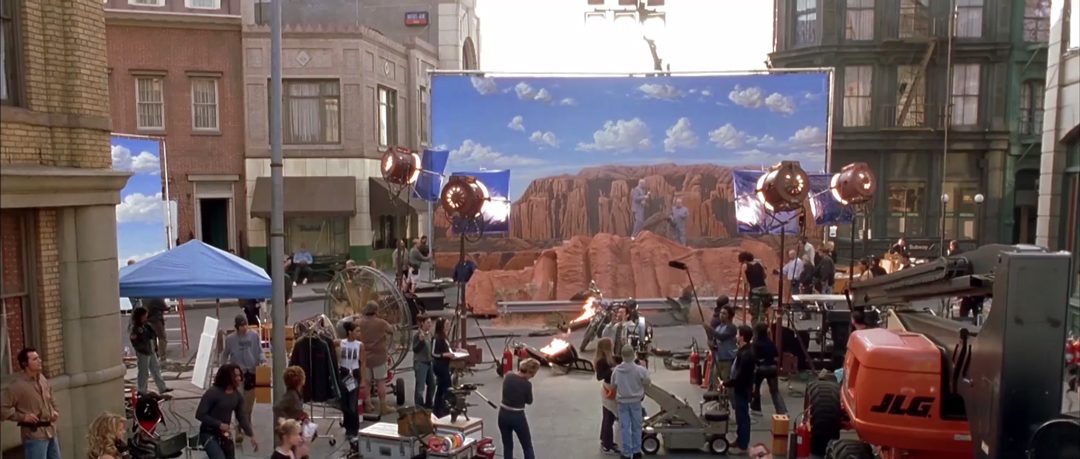
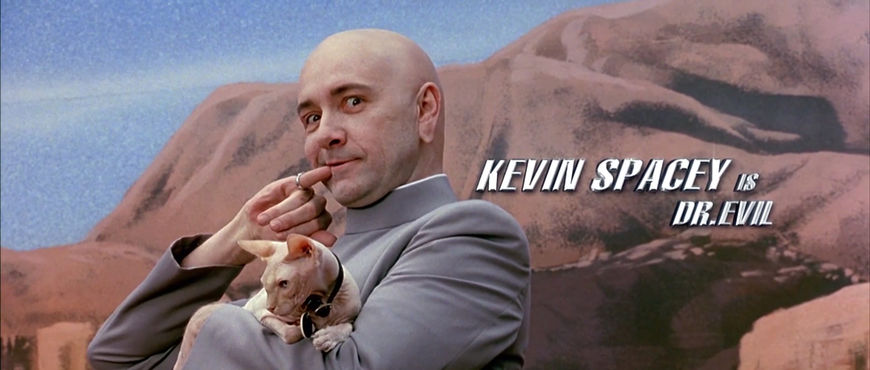
Was there discussion of having Tom Cruise wear the Austin Powers teeth?
Jay: We talked a lot about that! [laughs] But the whole idea was that there would be a beautification of Austin for Hollywood. [laughs] There would be a makeover, you know? Actually, it was funny, Tom wanted to wear them, to be honest, because he thought it would be cool to dress himself down. But I actually had a nice talk with him that morning, and I just said, “I hear you, I know it would be funny, but the whole idea of this is that a Hollywood version of this would take advantage of the Tom Cruise sex appeal and if we give you those teeth, that’s over.” So he agreed to do it. [laughs]

Jay: We had all the sets on rollers and we even shot Spielberg with the Oscar that leads Mike into the dancing all in one day. I was like, “Oh my god!” [laughs] That was the most frantic day. I was so proud of what it turned out to be once I saw it, but at the time, I was like, “I don’t know how this is gonna work! I’m still shooting! Where’s Kevin Spacey! Where’s Danny DeVito!” [laughs]

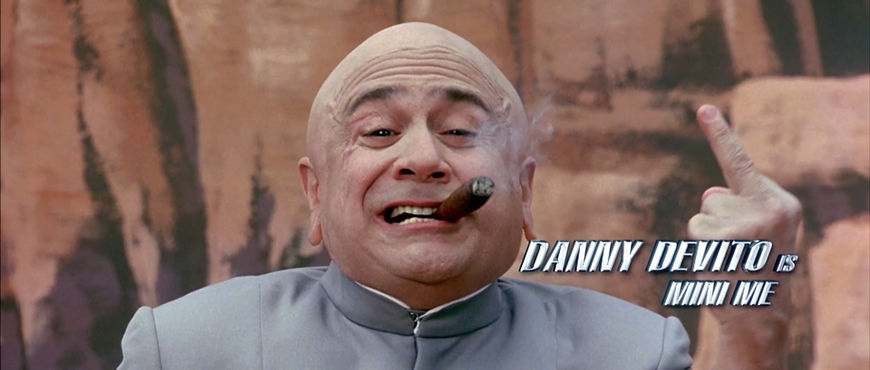
Right, and now the sequence has moved to the studio lot, with Spielberg and the crew dance members. Spielberg’s double does the set of flips…
Marguerite: Oh, yeah! Spielberg does the flips this time, whereas in the first one the bobby is doing the flips. So Spielberg does the flips, and my dancers are dressed as the crew and they come together and do a jazz routine. We really wanted to do a jazz routine, like West Side Story. We were all very familiar with the song by now, ‘cause it’s the same piece of music! [laughs] And then how they ran was Mike’s idea. That silly run came from Mike.
Behind-the-scenes video for the backlot crew dance sequence, featuring commentary from director Jay Roach and choreographer Marguerite Pomerhn Derricks
Next up is that Singin’ in the Rain sequence. Can you tell me about that?
Marguerite: When we shot the Singin’ in the Rain sequence it was really raining that day. It was really raining out and it was super cold. We were outside, you know, really dancing in the rain. I do remember that being a little challenging.
Jay: That was tough because it really was thousands of gallons of water raining down on all of us, but Marguerite just knocked it out of the park and our production designer Rusty Smith just did a fantastic job. The costumes that Deena Appel did were mind-blowingly good. It was just a great feast of all these people’s work.
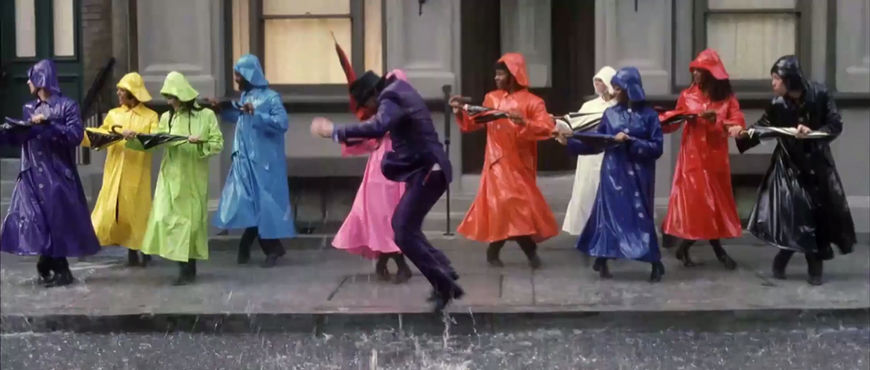
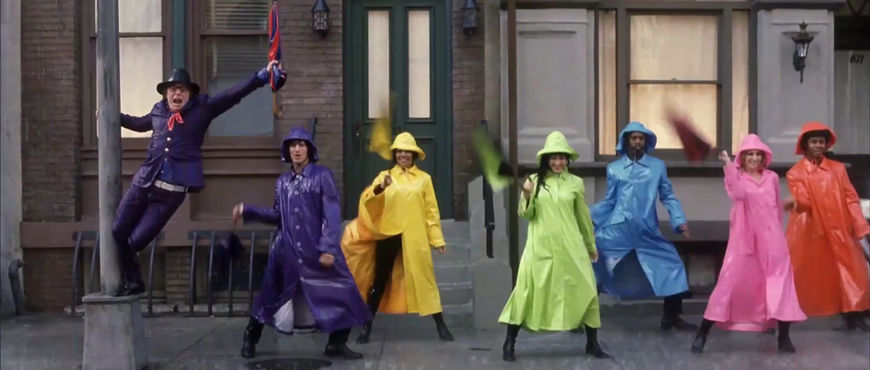
Marguerite: Mike had told me he was a great tap dancer. So I put this whole big tap number together, but it turned out all he could do was a shuffle and a flap! He said he was a great tap dancer, but he only had those couple of moves. I had to change the whole routine to include only shuffles and flaps which made it so friggin’ funny! It just made it even funnier.
Jay: With Singin' in the Rain, and The Umbrellas of Cherbourg, that imagery and the colours on the backlot was amazing to us. That’s the idea that Austin would connect to a history of cinema by going through these backlots. The other thing is just breaking the fourth wall of the fancy Hollywood version and then going back to a less technical, less advanced cinema grammar. The magic of what people do on backlots…
Singin' in the Rain (1952) main title sequence
Jay: And then to get to go and honour Buster Keaton, where Mike comes off the screen and then runs down into the orchestra pit and high-fives with Quincy Jones!
Then they stumble into that Britney Spears video shoot...
Jay: We did that ’cause we had Britney Spears! [laughs] She said she would do it!
Marguerite: Yeah! Mike really wanted to battle Britney. And so the whole thing was, having it start out like this pop video, and then here he comes, and it’s West Side Story, him with his girls and her with her boys.
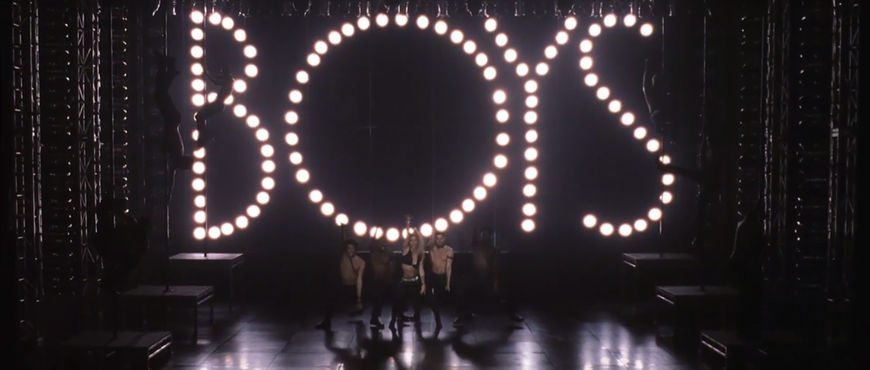
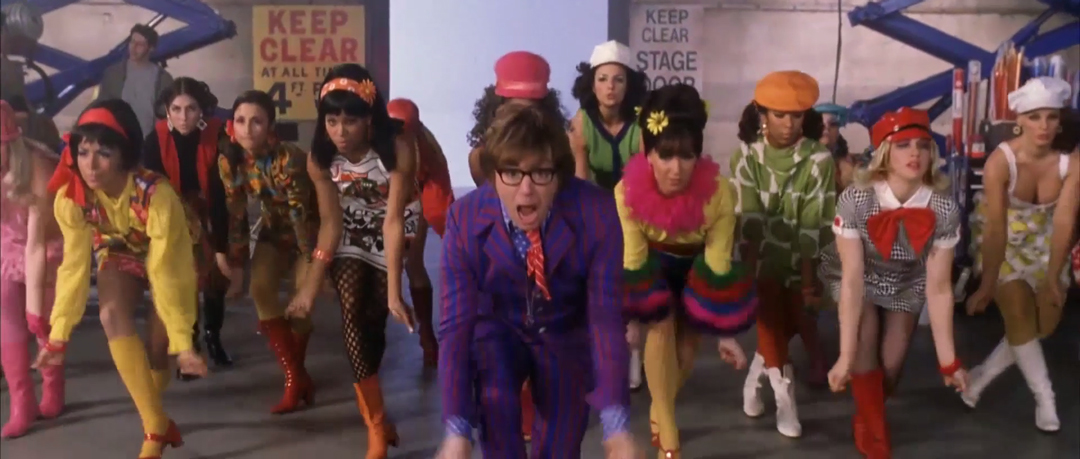
Jay: We thought it would be funny to break our own set of rules and do that West Side Story homage with the snapping fingers and the kind of Jets-versus-Sharks look between her dancers and our dancers, and then the guns come out of the bra, and the slap-fight thing.
Did Britney’s team have pre-existing choreography?
Marguerite: No! I put in a couple of her dancers that made her comfortable as the guys that she danced with but it was all my choreography that they did. Britney and Beyoncé were such lovely girls. They came in and just put themselves in my hands.
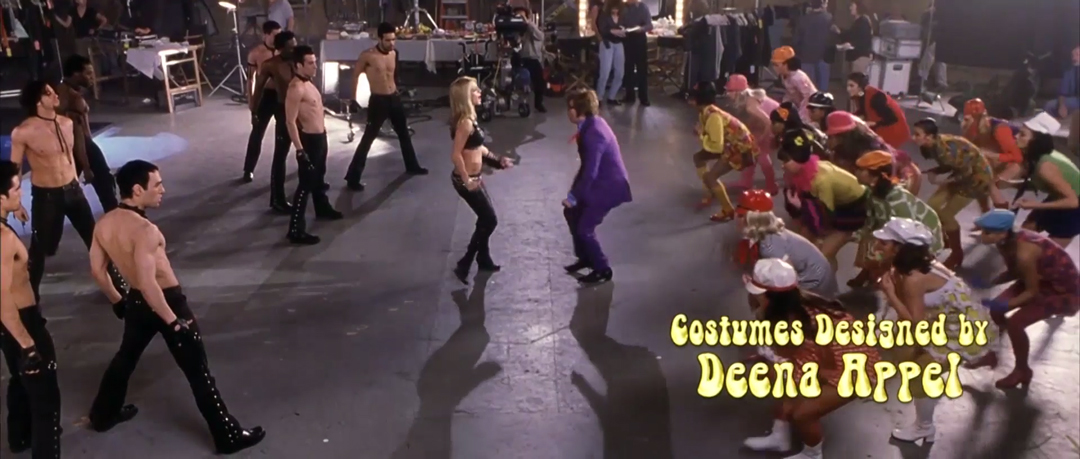
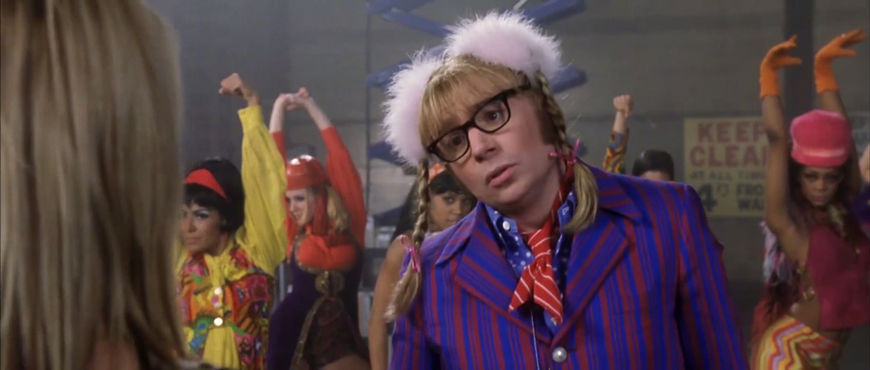
What does West Side Story mean to you as a choreographer?
Marguerite: It’s so timeless. It’s still good. Sometimes you see choreography and it becomes dated or it was really great when you saw it the first time and then time passes and all of a sudden you go, “Oh… okay.” West Side Story is always genius.
And then next is the grand finale, outside on the lot.
Jay: It’s this gigantic kitchen sink thing through the gates at Paramount with every possible kind of character. Little people, Lincoln on stilts… The stunt guy did – I tried to count them – I think he does almost a dozen handsprings and then does what we call a Texas Switch, when he ducks under the camera, and then Mike pops up right in front of the camera. He was standing on a crane at that point and the crane raises up into the sky and all that stuff is going on behind him, and there you have more animated graphic characters.
Behind-the-scenes video detailing the making of the elaborate finale of the main title sequence as well as a visual effects breakdown, featuring commentary from director Jay Roach
Marguerite: And Mike – at the very end of the sequence – when he raises up in front of Paramount and everybody’s dancing below, I always was on a bullhorn. I always counted Mike in. Mike wouldn’t move until I said, “Five, six, seven, eight!” That was just how everything went.
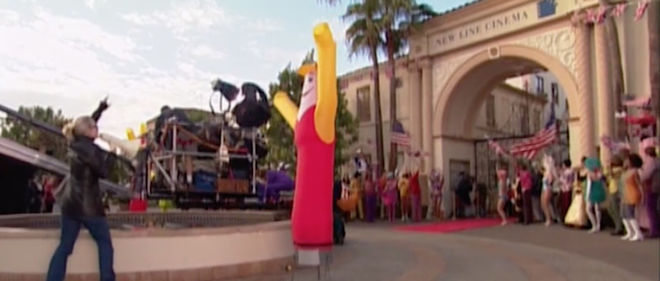
Choreographer Marguerite Pomerhn Derricks (bottom left) shouts cues on the set of Austin Powers in Goldmember
Jay: I keep meaning to bring it up but I always forget so I’ll share this with you. I asked Mike, “What else could we possibly have worked into this shot?” There’s nothing else we could fit. There’s no room for any other – [laughs] – any other comedy or cinematic characters or elements. Then once the graphics come in it’ll be even more crowded. He kept saying, “I don’t know… Maybe…” I said, “What? What could there possibly be?” He said, “Well, would it kill you to have somebody juggling kittens with sparks coming out of their ass?” I said, “Uh, I don’t have that setup so yeah, we’re not gonna do that.” But! My brilliant visual effects guy who’s been with us on all those films, David Johnson, is just astonishingly good. I know how to juggle so I juggled these stuffed kittens… and Dave patched me in. I’m juggling stuffed kittens down in the bottom-left corner at the end of the shot, and he actually made – with visual effects – sparks coming out of my ass.
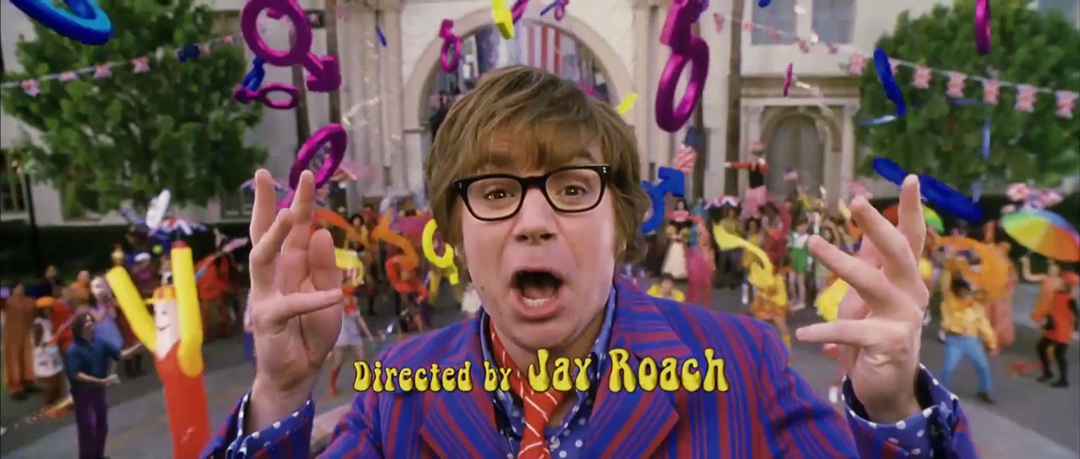
Still from the Austin Powers in Goldmember main titles. Director Jay Roach appears in the bottom-left of the frame, shooting sparks and juggling kittens.
Oh, my god. How have I never noticed this before?
Jay: Yeah! There I am! It’s like a little Where’s Waldo moment. No one ever notices it because you’re thinking about Mike and you’re seeing this incredible scene. But that was a pure joke for Mike, not for the audience. I put it in so I could later point to it and go, “See, I gave you everything you’ve ever asked for.” [laughs]
When you look back on this project, what do you feel and what has this meant for you as a creator?
Marguerite: I feel very proud of it. It really elevated me as a choreographer. This put me on the map as a choreographer. I worked a lot in comedy because of them. I really learned about musical comedy from Mike Myers, you know? Then I got to do movies with Will Ferrell and Ben Stiller and Cedric the Entertainer and Steve Harvey. I became the comedic guys’ girl and it comes from my work on Austin Powers specifically and with Mike Myers.
Jay: He gave me such an opportunity with those films. I’d been to film school, I’d done a lot of work as a cameraman, I’d written, I’d been sound guy, editor, I’d done everything. I’d always wanted to direct. But it was 10 years almost to do the day after I graduated when I got the job doing Austin. I was probably gonna keep writing and messing around. I was starting to do music videos. But when he offered me that gig and fought for me to get it, it was – it changed everything and completely created a career I got to have.
Is there anything I haven’t asked that you want to mention?
Jay: No, I’ve shared a lot more than I expected to! [laughs] I really appreciate the interest. I’m really glad the third film’s gonna make it on the site ‘cause it really was an evolution to that one.
It’s the most elaborate – we have to!
Jay: [laughs] We finally got the sharks! Beautiful. Thank you.

